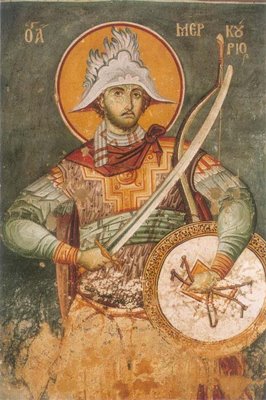Digenis
Acritis (Greek: Διγενης Aκρίτης),
known in folksongs as Digenis Acritas (Greek:
Διγενης Aκρίτας),
is the most famous of the Acritic Songs. The epic details the life of its
eponymous hero, Digenes, a hero of mixed Roman and Syrian blood. The first part
of the epic details the lives of his parents, how they met, and how his father,
an Emir, converted to Christianity after abducting and marrying Digenes’
mother. The remainder of the epic discusses, often from a first-person point of
view, Digenes’ acts of heroism on the Byzantine border.
The Digenis Acrites is an extensive narrative text, although it is not in a pure epic-heroic style. It survives in many manuscripts and versions, the oldest two being the Escorial and Grottaferrata versions, from the names of the libraries in which the respective manuscripts are held. While it should be noted that the form (or forms) in which it has survived is not the product of oral composition, it has nevertheless retained a considerable number of features of its oral origins. The common core of the two versions preserved in the E and G manuscripts goes back to the twelfth century. The text of E appears to be closer to the original composition while G represents a version that is heavily marked by learned reworking. Both texts give enchanting descriptions of the life of the martial societies of the border regions of the empire,

while in the figure of
Digenis are concentrated the legends that had accumulated around local heroes.
The Escorial version is the superior of the two in respect of the power and
immediacy of the battle scenes and austerity of style. The epic descriptions of
the mounted knights and battles are marked by drama, a swift pace and lively
visual detail.
The
Byzantine-Arab conflicts that lasted from the 7th century to the early 11th
century provide the context for Byzantine heroic poetry written in the
vernacular Greek language. The acrites of the Byzantine Empire of this period
were a military class responsible for safeguarding the frontier regions of the
imperial territory from external enemies and freebooting adventurers who
operated on the fringes of the empire. The work comprises two parts.
In
the first, the “Lay of the Emir”, which bears more obviously the
characteristics of epic poetry, an Arab emir invades Cappadocia and carries off
the daughter of a Byzantine general. The emir agrees to convert to Christianity
for the sake of the daughter and resettle in Romania (Ρωμανία,
the lands of the Ρωμηοί or mediaeval and early
modern Greeks) together with his people. The issue of their union is a son,
Digenis Acrites.
The
second part of the work relates the development of the young hero and his
superhuman feats of bravery and strength: like his father, he carries off the
daughter of another Byzantine general and then marries her; he kills a dragon;
he takes on the so-called apelates (Aπελάται),
a group of bandits, and then defeats their three leaders in single combat. No
one, not even the amazingly strong female warrior Maximu, with whom he commits
the sin of adultery, can match him. Having defeated all his enemies Digenis
builds a luxurious palace by the Euphrates, where he ends his days peacefully.
Cypriot legend has it that he grabbed hold of the Pentadaktylos (Five Fingers)
mountain range in occupied Cyprus in order to leap to Asia Minor (Present day
Turkey), the mountain range, as the name suggests, resembles five knuckles
sprouting from the ground.
The
Digenis continued to be read and enjoyed in later centuries, as the text
survives in various versions dating to as late as the 17th century. The epic
tale of Digenis Acrites corresponds in many ways to a cycle of much shorter
Acritic songs, from especially Asia Minor, Cyprus and Crete, some of which
survived till today. In the later tradition Digenis is eventually defeated only
by Death, in the figure of Thanatos/Charos, after fierce single combat on “the
marble threshing floors”. Thanatos had reportedly already wrestled with
Heracles.